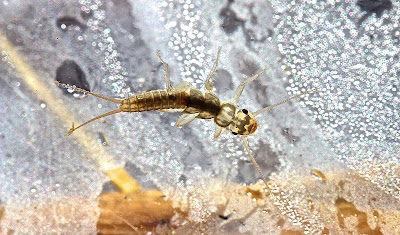I was hoping -- and expecting -- to see two new insects (new for the season) at the South River this morning, and see them I did: the Perlodid stonefly, Isoperla namata, and the Large winter stonefly, Taenionema atlanticum.
I. I. namata
When the I. namatas mature, they look like the nymph in the photo at the top of the page, a photo taken this spring on 3/26. Size: ~11 mm. Those I was finding today, of course, were much smaller (5-7 mm) and much less colorful. Here are a few of the many I found in the leaf packs.
The nymphs today were at various stages of maturation, which we can see in the development of the distinctive pattern we see on the head of I. namata. First, have another look at nymph that is fairly mature. This one was found on 4/11.
Like all Isoperlas, I. namata has three stripes that run the length of the abdomen, and if you look closely you can see those stripes on the nymphs I was finding today. But, look at the pattern we find on the head. I. namata nymphs commonly have, as we see here, dark bands that extend from the transverse band on the head back to the rear ocelli, and sometimes, as we also see here, beyond, to the back edge of the head. Between those bands or bars, the head is yellow. In the nymphs from today, we can see three stages in the development of that pattern.
1. The backward extension of the dark transverse band has not yet separated into two bars, and the yellow space in between has not yet appeared.
2. The bars extending back from the band have started to divide and some yellow is showing.
3. And in the most mature nymph that I found, the head pattern is fully developed.
Pretty neat! I. namata, you may recall, is the most common Isoperla Perlodid stonefly we find in our streams, also the most prolific. It's somewhat tolerant for a stonefly -- 2.5 -- which may explain why we see them in almost all of our streams in the winter and spring.
_______________
II. And then there were three: the large winter stonefly, Taenionema atlanticum.
These too, are very small at this point, around 5 mm. T. atlanticum nymphs can also be 11 mm by the time they're mature -- when they look something like this (photo from 2/2).
And this one I found in South River on 1/11 this year.
T. atlanticum is clearly less colorful than T. burks/maura and S. fasciata, the other large winters we commonly see, but it's also the least tolerant of stream impairment, and it prefers small mountain streams. To date, I've only seen this large winter species in the Rapidan, South River, the upper Doyles River, and in the small streams I explore in Sugar Hollow.
Like all winter stoneflies, T. atlanticum nymphs like to curl up when you put them into a tray --
But if you look closely at the tip of the abdomen in this photo, you'll notice that T. atlanticum nymphs, just like the S. fasciata nymphs that I found yesterday, have a "ventro-apical plate."
Now, there is a Strophopteryx species -- S. limata -- that is uniformly brown, just like T. atlanticum (see Beaty, "The Trichoptera of North Carolina," p. 7). But you can tell Strophopteryx and Taenionema nymphs apart by the shape of that ventro-apical plate. The Strophopteryx plate is concave laterally, it curves in:
_______________
I got some great pix today of some prong-gilled mayflies, and I'll show them here at the end. These are genus Paraleptophlebia, and I preserved one, hoping that I can work out the species ID.
These are great because these nymphs still had all of their gills and all of their legs!



















No comments:
Post a Comment